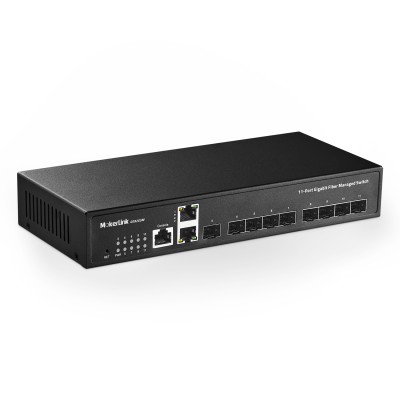Power over Ethernet (POE) technology sends 10/100/1000 Mbps of data and 15W, 30W, 60W, and up to 90W of power budget to devices over Cat5e and Cat6 Ethernet cables for a maximum distance of 100m.
PoE technology relies on the IEEE 802.3af and 802.3at standards, which are set by the Institute of Electrical and Electronics Engineers and govern how networking equipment should operate in order to promote interoperability between devices.
PoE-capable devices can be power sourcing equipment (PSE), powered devices (PDs), or sometimes both. The device that transmits power is a PSE, while the device that is powered is a PD. Most PSEs are either network switches or PoE injectors intended for use with non-PoE switches.
Common examples of PDs include VoIP phones, wireless access points, and IP cameras.
What is the advantage of PoE?
Power over Ethernet (PoE) allows for installation of remote or outside equipment without having to connect to AC power. This allows power to be delivered to more areas without the need to install additional electrical infrastructure or to have power outlets at every endpoint. Equipment can be installed without the need for an electrician and because ethernet cable costs less and is often already installed in buildings, PoE-based systems are far more cost-effective and efficient.
What are the benefits of PoE?
PoE benefits organizations in 5 primary ways—reduced installation costs, installation safety, responsive deployments, data-gathering capabilities, and productivity enhancements. End users can plug PoE capable devices into existing networks or start from scratch with ease.
Here’s an explanation of the list above:
1. Why does PoE reduces installation costs?
PoE installation costs are far less than the cost of installing traditional wiring, and the operating costs are far more efficient. One twisted pair cable delivers both data and power to devices. Existing copper from legacy phone systems can also be repurposed.
PoE injectors and splitters save money by allowing IT pros to combine legacy devices with newer, more efficient PoE networking components.
They also allow organizations to add remote devices without having to install electrical infrastructure. Injectors and splitters are designed to provide power to and from non-PoE compliant equipment.
These inexpensive units will add years to a legacy system and can literally save thousands of dollars by bypassing the installation electrical outlets in remote locations.
2. Why is PoE Installation safer?
PoE Type 3 voltages are typically less than 60 volts, and Type 4 less than 90. Conduits and metal cladding are not required. Fewer steps and hazards and the straightforward use of one Cat5e or Cat6 Ethernet cable, remove the need for a licensed electrician.
3. Why are PoE deployments more responsive?
PoE devices adapt to changing environments. They can be easily moved and reconnected at the switch level and easily integrate into changing network configurations. PoE is plug and play. An entire network does not need to be brought-down to add or subtract devices.
4. What are PoE data-gathering capabilities?
PoE technology is perfect for data collection. For example, analytics software can help facilities groups to determine when an area is occupied and when LED lighting and HVAC components may be turned off. Operational costs can be much lower based on actual usage.
5. Why PoE enhances productivity?
LED lighting systems, because of 2-way data capabilities, can be programmed to follow spectrum and frequencies found in nature. Employees can enjoy greater health, alertness, creativity, collaborative opportunities, and a sense of well-being while on the job.
All of these features allow organizations the ability to control and limit costs without sacrificing quality of life.


